
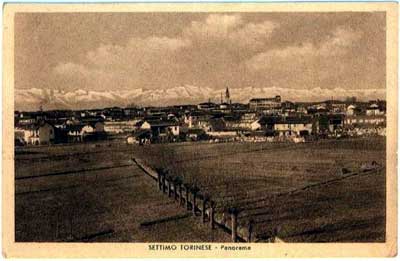
Fig
1
The town
of Settimo Torinese (Fig.1,2 and 3), situated a few miles
east of Turin, on the northern shore of the river Po, became
the undisputed capital of Italian pen production in the years
spanning from the end of WWI to the beginning of the 1970s..
In this small industrial town at the peak of its expansion
in the 1950s, over 160 pen manufacturers were engaged in manufacturing
high quality and very well made fountain pens of reasonable
cost.
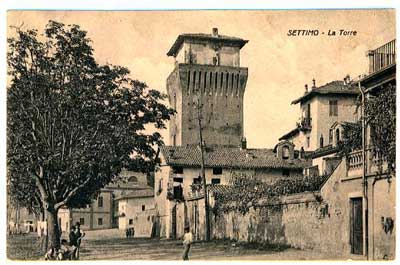
Fig
2
This article
aims to show the history of one of the less known Italian
pen companies which evolved from simple beginnings to become
one of the very best Italian pen manufacturers.
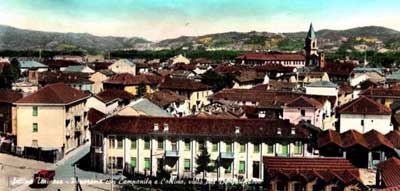
Fig
3
The
Williamson pen company
The origin
of this pen company stems from some very unique circumstances.
Williamson was an american manufacturer of steel nibs that
was already active in the early 1800s. Their output was of
the highest quality, rivaling the best English steel nib producers
and their products were adopted as standard issue by U.S.
government offices. During the first years of the last century,
the Williamson Co. established a factory in Janesville (Wisconsin,
USA), not far from the Parker plant, and began production
of reliable and well made hard-rubber fountain pens. It was
at this time of considerable success and expansion for the
Williamson Pen Company that a Turin businessman named Riccardo
Amisani began importing their pens into Italy.
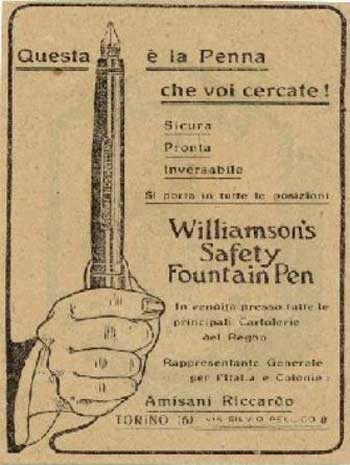
Fig
4
Italy,
just before the First World War (Fig. 4) was a relatively
new Country, having finally gained its independence in 1861.
The North of the Country was thriving, with many new industrial
activities launched in an industrial revolution that, while
late if compared with the development of industry in Great
Britain, nevertheless brought a new level of prosperity and
produced the rapid growth of a relatively affluent middle
class. The Williamson pens sold very well in Italy and the
Williamson name became a respected and admired marque among
foreign pen manufacturers.
Boosted
by this success, Mr. Amisani started building spare parts
for Williamson pens in a small workshop located in Settimo
Torinese. Unfortunately, Williamson pens fared a lot worse
in their home market and, under pressure from formidable competitors
such as Parker, Waterman's and Wahl, just to name a few, the
company eventually folded in the late 20s.
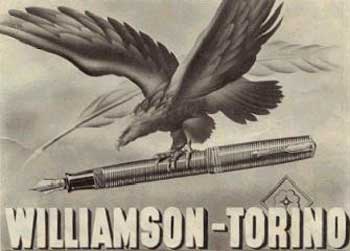
Fig
5
At this
point, Mr. Amisani made a bold decision: he would continue
to produce Williamson pens in his shop in Settimo Torinese.
Under Mr. Amisani's management, the company continued to grow
and produced some truly excellent pens. In our opinion, the
best of the Williamson pen production occurred during the
'30s (Fig.5) . During this decade, the Penne Williamson-Torino
company (as it was now officially designated) borrowed heavily
from the designs of two American pen makers, namely Parker
and Eversharp.
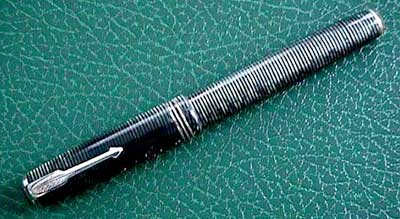
Fig
6
One
of their first designs was a gorgeous, oversize pen which
was clearly inspired by the Parker Vacumatic (Fig 6, 7 and
8).
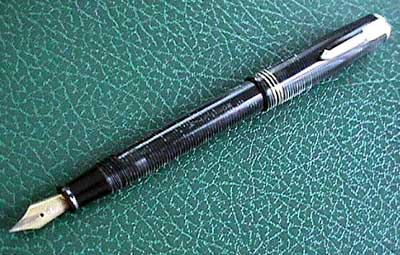
Fig
7

Fig
8
Like
the Vacumatic, the Williamson pen was machined from a rod
of laminated celluloid and sported shiny black "jewels"
at both ends. Unlike its American counterpart, however, the
ink filling mechanism of the Williamson was of a simple and
proven design: a classic button-filler, closely resembling
the one used in the Parker Duofold. Williamson nibs were numbered
and for its flagship models the company installed a No. 6
nib (Fig. 9).  Interestingly,
the company adopted a Christmas-tree-type feed, once again
showing the influence of the Duofold pen. These pens are graced
by three metallic rings around the cap, just above the lip
and they employ a beautiful and interesting variant on the
Parker "arrow" clip: instead of depicting an arrow,
the clip, resembling in its overall shape the one used by
Parker, is embellished with a long, flowing quill. The overall
impression is that the slender Parker-type clip is made even
more beautiful by the rendered feather motif. Fig. 10 shows
a detail of this beautiful pen clip. Interestingly,
the company adopted a Christmas-tree-type feed, once again
showing the influence of the Duofold pen. These pens are graced
by three metallic rings around the cap, just above the lip
and they employ a beautiful and interesting variant on the
Parker "arrow" clip: instead of depicting an arrow,
the clip, resembling in its overall shape the one used by
Parker, is embellished with a long, flowing quill. The overall
impression is that the slender Parker-type clip is made even
more beautiful by the rendered feather motif. Fig. 10 shows
a detail of this beautiful pen clip.
Another
high quality pen produced by Williamson in the '30s and '40s
was a marbled celluloid 12-faceted pen that has a passing
resemblance to the Wahl Eversharp Doric (Fig.11 and 12). The
Italian pen, however, is considerably larger and of wider
girth than even the oversize variant of the Doric. This Williamson
pen was a lever-filler and sported the same high quality gold
nibs as its button-fill counterpart. The cap ended in a shallow
cone and was enriched by three thin gold bands. The clip was
of simple design, understated to the point of being almost
plain looking, the quality of the workmanship is superb. For
this pen, Williamson used an array of incredibly beautiful
patterns, some of them in translucent celluloid; the marbled
celluloids were impeccably polished to a high gloss and their
patterns and colors are quite beautiful. These celluloids
have resisted discoloration and staining very well through
the years.
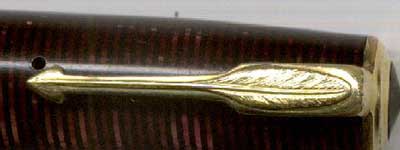
Fig
10
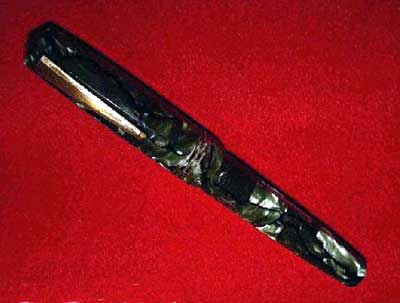
Fig
11
These
pens have become treasured collectibles and are actively sought
after by lovers of classic Italian fountain pens.
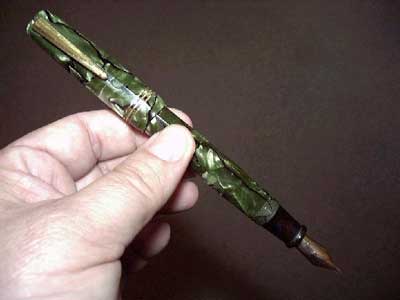
Fig
12
After
the revolution caused by the introduction of the Parker 51
(post-WW2, in Europe), Italian pen manufacturers rushed to
produce look-alike, hooded nib fountain pens. Out of several
attempts, one turned out to be particularly inspired: the
Aurora 88, designed by Marcello Nizzoli, became a commercial
success and an instant classic. The pen sold in the millions,
both in Italy and abroad and, in the early 1950s, it was the
pen of the writing elite. Williamson's swan song was a slim
and graceful pen clearly inspired by the Aurora 88. The Parker
Vacumatic influence, however, could still be found in the
material used by Williamson for this pen of the "Atomic
Age": the Williamson hooded-nib pen was machined out
of laminated celluloid: one last link between fountain pen
designs that had characterized two distant eras and two very
different ways of interpreting the very concept of a modern
writing instrument.
All this
was soon to be changed by the arrival of Mr Laszlo Birò's
invention, fresh from Argentina and soon to be made ubiquitous
by Baron Marcel Bich, relegating for many years the classic
fountain pen to the role of an almost forgotten anachronism.
That spelled the end of "Penne Williamson - Torino",
together with many other smaller manufacturers whose names
have often been forgotten
Still,
if you are lucky enough to own one of Mr Amisani's creations,
you hold a piece of pen history and a pen that is unique in
having its roots in 19th century America and its blossoms
in the Italy of the 1930s.
|


